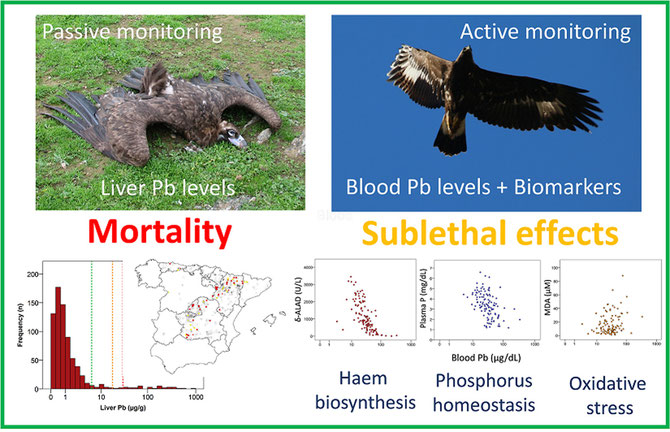
A recently published research article used active and passive monitoring methods to assess sublethal effects and mortality from lead poisoning in birds of prey in Spain, confirming the high risk of this silent threat.
Overview
Lead (Pb) is toxic and poses a silent but severe threat to wild animals. Vultures and birds of prey can unintentionally ingest lead shot pellets or fragments of bullets scattered in game animals, which can cause adverse effects on their health. Even though these birds can regurgitate the ingested lead ammunition eventually, the low pH of their digestive system facilitates lead absorption and increases the concentration of this toxic metal in their blood and other tissues, often resulting in lead poisoning.
In Spain, mortality from lead poisoning has been widely reported in birds of prey in species such as the Cinereous Vulture (Aegypius monachus), Griffon Vulture (Gyps fulvus) the Egyptian Vulture (Neophron percnopterus) as well as other protected species. Despite this, lead ammunition is still available in Spain. However, using lead rifle bullets for hunting is partially banned in some areas to protect species such as the Bearded Vulture (Gypaetus barbatus). Since the ingestion of lead ammunition is the most common exposure pathway to this toxic substance in birds of prey, more measures need to be implemented to minimize the threat of lead poisoning in birds of prey.
A research study was conducted to better understand the extent and risk lead exposure to birds of prey in Spain.
Methods
The research team obtained samples from both passive and active monitoring to provide a complete assessment of the risk by posed by lead for raptors as these methods can inform about levels of both exposure and effects. Between 2004 and 2020, the team performed passive monitoring of lead poisoning in birds of prey by measuring liver (n = 727) and blood (n = 32) lead levels in individuals of 16 species found dead in the field, or admitted sick or dying to rescue and rehabilitation centres in Spain. The active monitoring involved measuring blood lead levels and biomarkers of haem biosynthesis, phosphorus (P) and calcium (Ca) metabolism, oxidative stress and immune function in individuals (n = 194) of 9 species trapped alive in the field between 2016 and 2017. Active monitoring also helped acquire a less biased understanding of the situation.
Results
The passive monitoring results revealed severe clinical poisoning indicated by Pb liver levels (>30 μg/g d.w. of Pb) in species like the Griffon Vulture (27/257, 10.5%), Red Kite (1/132, 0.8%), Golden Eagle (4/38, 10.5%), and Northern Goshawk (1/8, 12.5%). Active monitoring results demonstrated that Bearded Vulture (1/3, 33.3%), Griffon Vulture (87/118, 73.7%), Spanish Imperial Eagle (1/6, 16.7%) and Red Kite (1/18, 5.6%) individuals had abnormal blood lead levels (>20 μg/dL). Analysis of results further showed that blood lead levels increased with age, and both monitoring methods showed seasonality in lead exposure associated with a delayed effect of the hunting season.
Finally, the study confirms that lead poisoning is an important cause of death and can result in sublethal effects on haem biosynthesis, phosphorous metabolism and oxidative stress in birds of prey in Spain.
Conclusion and recommendations
Up until today, 13 raptor species have been detected with clinical lead poisoning in Spain, of which the cases of 5 new species were discovered within this study, representing a significant proportion of the diagnosed poisonings (8.1%) and the total dead birds (5.0%) studied here. Lead poisoning can also result in adverse sublethal effects to a much higher proportion of birds of prey, based on the results of blood lead concentrations (i.e. 73.6% of Griffon Vultures). The subsequent consequences on bird fitness must be studied to identify any impacts on the affected populations’ long-term conservation.
Ammunition is considered the most common cause of lead poisoning in raptors, and this is reflected in another recently published research that studied lead exposure in Common Buzzards in the UK. This study confirmed that shotgun ammunition was the primary source of exposure to lead, identifying that 89% of the mass of lead in livers of buzzards with acute exposure was from ammunition.
There are solutions to this problem, including the use of non-lead ammunition for hunting and shooting, such as shotgun cartridges with steel pellets and copper bullets for the hunting of deer and other game species. Recently Denmark became the first country in the world to totally ban lead hunting ammunition, recognizing the threat that it poses to wildlife, the wider environment and human health.
We here at the Vulture Conservation Foundation (VCF) are committed to tackling the threat of lead poisoning as it poses a limiting parameter in the conservation of vultures in Europe. We are working alonside many partners towards a gradual and consensual elimination of lead ammunition from vulture habitats, and have also contributed to calls for evidence from the European Chemical Agency (ECHA) of the European Union. More information on what is currently being done as well as VCF’s future goals regarding minimizing this threat can be found in this blog post.
Source
Descalzo, E., Camarero, P., Sánchez-Barbudo, I., Martinez-Haro, M., Ortiz-Santaliestra, M., Moreno-Opo, R., & Mateo, R. (2020). Integrating active and passive monitoring to assess sublethal effects and mortality from lead poisoning in birds of prey. Science Of The Total Environment, 750, 142260. https://doi.org/10.1016/j.scitotenv.2020.142260



